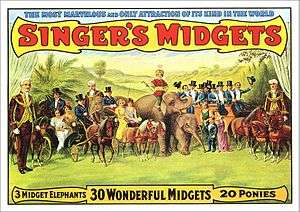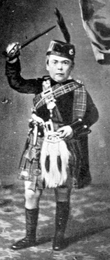Midget

Midget (from midge, a sand fly[2]) is a term for a person of unusually short stature that is widely considered pejorative.[3][4][5][6] While not a medical term, it has been applied to persons of unusually short stature, often with the medical condition dwarfism,[7] particularly proportionate dwarfism.[8][9]
It may also refer to anything of much smaller than normal size, as a synonym for "miniature",[10] such as a midget cell, a midget crabapple, MG's Midget, Daihatsu's Midget, and the Midget Mustang airplane; or to anything that regularly uses anything that is smaller than normal (other than a person), such as midget car racing and quarter midget racing; or a smaller version of play or participation, such as midget golf; or to anything designed for very young (i.e., small) participants—in many cases children—such as Disneyland's Midget Autopia, Midget hockey, and Midget football.[11]
History

Merriam-Webster dictionary states that the first use of the term "midget" was in 1816.[8]
Little people have always been popular entertainers, but were often regarded with disgust and revulsion in society. In the early 19th century, however, little people were romanticized by the middle class and regarded with the same affectionate condescension extended to children, as creatures of innocence.[12] The term "midget" came into prominence in the mid-19th century after Harriet Beecher Stowe used it in her novels Sunny Memories of Foreign Lands and Old Town Folks where she described children and an extremely short man, respectively.[13] P. T. Barnum indirectly helped popularize the term "midget" when he began featuring General Tom Thumb, Lavinia Warren and Commodore Nutt in his circus.[14] "Midget" became linked to referencing short people put on public display for curiosity and sport.[13] Barnum's midgets, however, were elevated to a position of high society, given fantasy military titles, introduced to dignitaries and royalty, and showered with gifts.[15][16]
Such performances continued to be widespread through the mid part of the twentieth century, with Hermines Midgets brought from their performances in Paris to appear at the 1939 New York World's Fair,[17] the same year that MGM released The Wizard of Oz, which featured 124 midgets in its cast, most of which were from the Singer's Midgets troupe.[18][19]
When interviewed for a 1999 piece, performers engaged in ongoing "Midget Wrestling" events stated that they did not view the term "Midget Wrestling" as derogatory, but merely descriptive of their small size; however, others responding to the piece disagreed, with one stating that the performances themselves perpetuated an outdated and demeaning image.[20]
As of the 21st century, the word became considered by some as a pejorative term when in reference to people with dwarfism.[21][7][13][22] One noted exception, though, was accomplished actor Hervé Villechaize who preferred the term "midget".[23]
See also
- List of restricted growth organisations around the world
- Leo Singer
- Munchkin
- Midget professional wrestling
- Midget-tossing
- Pygmy peoples
References
- ↑ Adelson, Betty M. (2005). The Lives Of Dwarfs: Their Journey From Public Curiosity Toward Social Liberation. Rutgers University Press. pp. 295–. ISBN 9780813535487. Retrieved 8 December 2012.
- ↑ Harper, Douglas. "midget". Online Etymology Dictionary. Retrieved 2008-04-03.
- ↑ Miller, P. S. (1987). "Coming up short: Employment discrimination against little people". Harv. CR-CLL Rev.
- ↑ Adelson 2005, p. ??.
- ↑ Gentry, Ruben; Wiggins, Ruby (15–16 November 2010). Individuals with Disabilities Are People, First--Intervene and They Will Learn. College of Education and Human Development Urban Education Conference. Jackson, Mississippi.
- ↑ "midget". Webster's II New Collegiate Dictionary (2nd expanded ed.). Boston & New York: Houghton Mifflin Company. 1999. p. 693. ISBN 0395962145.
1. An extremely small person who is otherwise normally proportioned.
- 1 2 Shapiro, Arthur H. (2000-09-01). Everybody Belongs: Changing Negative Attitudes Toward Classmates With Disabilities. Psychology Press. pp. 284–. ISBN 9780815339601. Retrieved 8 December 2012.
- 1 2 Merriam-Webster Dictionary Entry for midget: sometimes offensive: a very small person; specifically: a person of unusually small size who is physically well-proportioned.
- ↑ Kennedy, Dan (2005-05-23). "What is Dwarfism?". American Documentary. Retrieved 2008-10-11.
- ↑ The World Book Dictionary. WorldBook.com. 2003. pp. 1315–. ISBN 9780716602996.
- ↑ Driver, Bruce; Wharton, Clare (2004-10-20). The Baffled Parent's Guide to Coaching Youth Hockey. McGraw Hill Professional. pp. 15–. ISBN 9780071430111. Retrieved 15 January 2013.
- ↑ Ashby, pp. 50–51.
- 1 2 3 Kennedy, Dan. "P.O.V. - Big Enough. What is Dwarfism?". Public Broadcasting Service. Retrieved 2008-11-18.
- ↑ Thomson, Rosemarie Garland (1996). Freakery: Cultural Spectacles of the Extraordinary Body. NYU Press. pp. 191–. ISBN 9780814782224. Retrieved 8 December 2012.
- ↑ Charles Sherwood Stratton (AKA General Tom Thumb) and His Circle, Jack & Beverly's Images of Special Subjects, December 2005.
- ↑ Exhibit: "Sketch Of The Life, Personal Appearance, Character And Manners Of Charles S. Stratton, The Man In Miniature, Known As General Tom Thumb, And His Wife, Lavinia Warren Stratton; Including The History Of Their Courtship And Marriage, With Some Account Of Remarkable Dwarfs, Giants, & Other Human Phenomena, Of Ancient And Modern Times, And Songs Given At Their Public Levees" 1863 pamphlet, Press of Wynkoop & Hallenbeck, New York (Robert Bogdan Collection), The Disability History Museum.
- ↑ Cullen, Frank (2004). Vaudeville Old & New: An Encyclopedia of Variety Performers in America. Psychology Press. pp. 507–. ISBN 9780415938532. Retrieved 8 December 2012.
- ↑ Harmetz, Aljean (2013). The Making of the Wizard of Oz (75th Anniversary Updated ed.). Chicago: Chicago Review Press. p. 193. ISBN 1613748329.
- ↑ GoogleBooks Image for The Making of the Wizard of Oz Page 193
- ↑ Adelson 2005, p. 295.
- ↑ Adelson 2005, p. 6.
- ↑ Ross, Susan Dente; Lester, Paul Martin (2011-04-19). Images That Injure: Pictorial Stereotypes in the Media. ABC-CLIO. pp. 285–. ISBN 9780313378928. Retrieved 14 December 2012.
- ↑ "Victor & Billy". News From Me. Mark Evanier; originally published in Comics Buyer's Guide. 2001-01-19.